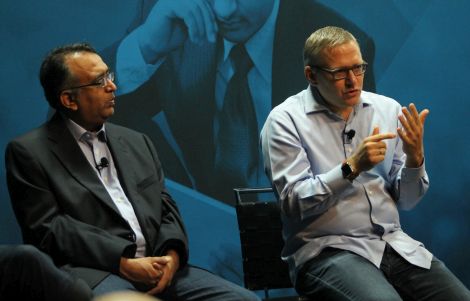In a rebranding effort that involves IBM, VMware announced this week the assembly of its key virtualization components – including vSphere, Virtual SAN, and NSX, the network virtualization agent – into a kind of VMware cloud stack that will be marketed as a single platform.
VMware Cloud Foundation, stated CEO Pat Gelsinger, will become available to new and existing customers through an as-a-service subscription model, the details of which, even now, have not been completely spelled out.
“We must address the next industry challenge,” said Gelsinger, “in this world, where clouds and devices and the complexities are accelerating ... the key aspect of VMware Cloud Foundation is delivering it as-a-service as well.”
Typically, when a vendor delivers a new product under an as-a-service model, it spells out whether subscriptions and licensing will be measured by time, by consumption, or by service category. Today, when we pressed VMware executives including the CEO for details about this model during a press conference, the responses we received were longer on vision than on detail.
“We can deploy VMware Cloud Foundation on-premise, as part of the customer’s data centers, or as part of the data center they’re running through their service provider,” responded Raghu Raghuram, VMware’s executive vice president and general manager for SDDC. “In that case, VMware Cloud Foundation will accept pre-existing licenses that customers might have purchased for vSphere, Virtual SAN, or NSX. And we’ll have appropriate tools for customers to go from one to the other.”
Whatever-as-a-Service
The promise of offering these components as-a-service, including through IBM, could be VMware’s biggest change announcement this year: the hope of freeing customers from what they portray as the most painful licensing constraints they’ve ever faced.
But that news is coming in small pieces at a time. IBM Cloud, for example, will be offering support for Cloud Foundation and will apply customers' existing VMware licenses to the use of VMware services on IBM Cloud, said Raghuram.
Think of Cloud Foundation as a grouping of VMware’s existing services for staging virtual workloads and virtual storage into a stack that is more conducive to managing a hybrid cloud. The off-premise part of that cloud comes from major public cloud providers: Amazon Web Services, Microsoft Azure, and Google Cloud Platform, as well as IBM Cloud and VMware’s own vCloud Air. Gelsinger stated Monday that Cloud Foundation’s support for staging and managing workloads on the “Big Three” platforms comes by way of working with their respective public APIs, not through any direct partnership or interaction between VMware and other firms.
While analyst Kurt Marko gave VMware executives an opportunity to apply Cloud Foundation to the needs of service providers and large data centers, in response, they made it very clear that Cloud Foundation wasn’t pursuing telcos and communications carriers, but mid- to large-size enterprises in general.

Left to right: VMware SVP Raghu Raghuram, CTSO Guido Appenzeller.
“When we started to think about Cross-Cloud Services... going into this, my assumption was, an enterprise would have one cloud and one strategic relationship, and go there,” admitted VMware Chief Technology Strategy Officer Guido Appenzeller. “And I don’t think I’ve ever talked to an enterprise that thinks of the cloud in that way. At this point, I’ve talked to over a hundred of them.”
With a typical customer adoption pattern, Appenzeller noted, one team builds an app within either on-premise resources or one public cloud, chosen by the team. Moving it between clouds would mean altering the application, but due to circumstances, the organization simply can’t shut the application down to make those alterations. So it needs a new staging mechanism.
If you ask that customer how many public clouds it would ideally prefer to be in, he continued, “the vast majority of the answers, about 70 percent, are saying, ‘We want to be in multiple public clouds, because there’s a major cost factor. We want multi-vendor so we’re not locked in. We might have geographic differences, performance differences, and we want to be able to leverage [different] pricing.
“There’s a desire for our customers to be in multiple public clouds,” the CTSO continued. “And I would argue it’s almost stronger in the larger enterprises.”
Cross-Cloud Services
In addition to Cloud Foundation, the newest component of VMware’s stack is its Cross-Cloud Services management component. During Monday’s keynote session, Appenzeller showed the audience an early tech preview of this SaaS-based component, which will be offered to select VMware customers for testing beginning today.
The key objective of this component is to keep track of public cloud resource consumption across public clouds: AWS, Azure, Google Cloud, IBM Cloud, and VMware’s vCloud Air and vCloud Air Network (still separate items). An administrator can perform service discovery of active applications across multiple clouds, cost analysis of resources consumed in each of these public clouds, and monitoring of active status.
As Appenzeller demonstrated, the service is actually a kind of wide-ranging NSX propagation system, deploying NSX instances throughout cloud-based workloads to serve as monitoring agents and policy enforcers. NSX’s existing policy template mechanism is being extended to apply way beyond the on-premise firewall, into public cloud territory.
The CTSO showed the creation of a simple policy that ensures the encryption of all traffic from one instance of an application, to another instance. That policy was obviously being enforced as those instances were split across public cloud boundaries. Non-encrypted traffic to the database tier was shown to have disappeared, indicating that the same policy being enforced on public clouds as on premises.
In another demo, Guido showed how a database-driven application using a separate database tier was migrated between two Azure data centers – one in the eastern US, the other in Ireland. The actual migration would still take hours, utilizing continuous replication, though he did present a fully-baked result. Key to this migration was that the workloads moved while the database was live, and while it remained in active use throughout.
During Monday’s press conference, VMware SVP Raghuram noted that subscriptions to VMware Cross-Cloud Services will be treated separately from the components in its new Cloud Foundation.





